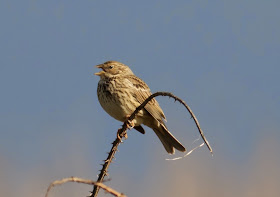For the final day of our long weekend I started with another pre-breakfast walk around Trevose Head in search of migrants. I started again by the golf course and on the road down to Boobies Bay there were a couple of Sedge Warblers, three Whitethroats and a Blackcap. There were good numbers of hirundines feeding over the fields but they were all Barn Swallows and Sand Martins. As I got to the beach 11 Whimbrel took off from one side of the golf course, flew over the road and landed the other side, they were the only Whimbrel I saw.
 |
| Whimbrel - Trevose Head |
I worked my way around the fields towards the headland, there was a distinct lack of migrants, although two Wheatears put in a brief appearance. With very little evidence of migrating birds I spent my time looking at the residents. The Skylarks were being quite lazy birds and rather than flying up high to sing, they were just sitting on fence posts singing. They were evidently very used to people and allowed me to walk right up to them for a few pics.
 |
| Skylark - Trevose Head |
It was a gloriously still and sunny morning and the light was fantastic.I was able to get some great shots, albeit of birds on posts.
 |
| Skylark - Trevose Head |
A Meadow Pipit was also being quite lazy and sitting on a rock and singing, again it was very approachable, and allowed me to get a few images before it flew off.
 |
| Meadow Pipit - Trevose Head |
Other than a constant stream of hirundines there was nothing to report of note, until that is I heard a singing Corn Bunting. There is a project on Trevose Head aimed at maintaining the dwindling population, but as with many schemes it seems to be failing in its aims. It seems that the conflicts with modern farming practices and farmland birds are not being resolved, and as is happening on my patch in Hampshire, species like Corn Bunting and Yellowhammer are disappearing.
 |
| Singing Corn Bunting |
In the end it was a very quiet morning with very few migrants to report, but overall I had had a fab weekend back in Cornwall.

















































